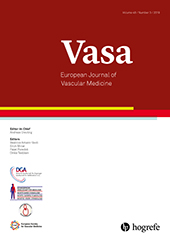Predictors for reoperation after lower limb amputation in patients with peripheral arterial disease
Abstract
Summary.Background: Major amputations in patients with peripheral arterial disease (PAD) carry a high risk for complications, including revision of the amputation, sometimes to a higher level. Determining a safe level for amputation with good wound healing potential depends largely on vascular measurements. This study evaluated potential predictive factors for revision of major lower extremity amputations in patients with PAD. Patients and methods: A retrospective chart review of all major lower extremity amputations at our institution was conducted. Amputations due to trauma or tumor and below-ankle amputations were excluded. Patient demographics, level/type of amputation, level/time of revision, comorbidities and risk factors were extracted. Results: 180 patients with PAD, mean age 66.48 (range: 31–93) years, 125 (69.4%) male were included. Most (154/180, 86.6%) underwent below-knee amputation. 71 (39.4%) patients had coronary arterial disease, 104 (57.8%) had diabetes. More than half of patients, (93/138; 51.7%) had undergone previous balloon angioplasty. 44 (30%) patients required revision surgery: 42/180 (23.3%) were revised at the same level, and in 12/180 (6.7%) a more proximal amputation was necessary. PAD stage was not associated with the level of reamputation (p = 0.4369). Significantly more patients who had previous balloon angioplasty required revision surgery (66.7% versus 45.2%, p = 0.009). 67 (37.2%) patients underwent preoperative TcPO2 measurement: 40/67 (59.7%) had TcPO2 ≥ 40 mmHg; 4/67 (6%) had TcPO2 < 10 mmHG. Three patients with TcPO2 ≥ 40 mmHg, one with 30 mmHg ≤ TcPO2 ≤ 40 mmHg and one with 10 mmHg ≤ TcPO2 ≤ 20 mmHg required re-amputation to a more proximal level. Conclusions: TcPO2 measurements are useful for determining level of lower limb amputation and predicting wound healing problems when an amputation level with TcPO2 < 40 mmHg is chosen. In transtibial amputations, TcPO2 ≥ 40 mmHg does not safely predict wound healing.
References
1 . The long-term mobility and mortality of patients with peripheral arterial disease following bilateral amputation. Eur J Vasc Endovasc Surg. 2003;26(1):59–64.
2 . Functional outcome in a contemporary series of major lower extremity amputations. J Vasc Surg. 2003;38(1):7–14.
3 . Functional outcome of below-knee amputation in peripheral vascular insufficiency. A multicenter review. Clin Orthop Relat Res. 1993;286:247–9.
4 . The below-the-knee amputation for vascular disease. J Bone Joint Surg Am. 1976;58(3):365–8.
5 . Segmental transcutaneous measurements of PO2 in patients requiring below-the-knee amputation for peripheral vascular insufficiency. J Bone Joint Surg Am. 1982;64(3):378–82.
6 . Improved results with diabetic below-knee amputations. Arch Surg. 1985;120(7):777–80.
7 . Lower extremity amputation: the control series. J Vasc Surg. 1986;4(4):321–6.
8 . Rehabilitation outcome 5 years after 100 lower-limb amputations. Br J Surg. 1994;81(11):1596–9.
9 Major lower extremity amputation: outcome of a modern series. Arch Surg. 2004;139(4):395–9;discussion 9.
10 Outcomes after 294 transtibial amputations with the posterior myocutaneous flap. Int J Low Extrem Wounds. 2014;13(1):33–40.
11 . Difficult to predict early failure after major lower-extremity amputations. Dan Med J. 2015;62(12):A5172.
12 . Below-Knee Amputation Failure and Poor Functional Outcomes Are Higher Than Predicted in Contemporary Practice. Vasc Endovascular Surg. 2016;50(8):554–8.
13 . Predictive Parameters for Clinical Outcome in Patients with Critical Limb Ischemia Who Underwent Percutaneous Transluminal Angioplasty (PTA): A Systematic Review. Cardiovasc Intervent Radiol. 2018;41(1):1–20.
14 . Estimating the prevalence of limb loss in the United States: 2005 to 2050. Arch Phys Med Rehabil. 2008;89(3):422–9.
15 . Mortality rates and diabetic foot ulcers: is it time to communicate mortality risk to patients with diabetic foot ulceration? J Am Podiatr Med Assoc. 2008;98(6):489–93.
16 . Amputation level selection in the diabetic foot. Clin Orthop Relat Res. 1993;296:68–70.
17 . Amputations in the diabetic foot and ankle. Clin Orthop Relat Res. 1993;296:64–7.
18 . Gait analysis in peripheral vascular insufficiency through-knee amputation. J Rehabil Res Dev. 1993;30(4):388–92.
19 . Gait analysis of dysvascular below-knee and contralateral through-knee bilateral amputees: a preliminary report. Orthopedics. 1993;16(8):875–9.
20 . Carbohydrate and fat oxidation in persons with lower limb amputation during walking with different speeds. Prosthet Orthot Int. 2017:309364617740237.
21 . Temporal Spatial and Metabolic Measures of Walking in Highly Functional Individuals With Lower Limb Amputations. Arch Phys Med Rehabil. 2017;98(7):1389–99.
22 , Duplex ultrasound for chronic venous insufficiency. J Invas Cardiol. 2014;26(11):E149–55.
23 . Ankle brachial index for the diagnosis of lower limb peripheral arterial disease. Cochrane Database Syst Rev. 2016;9:CD010680.
24 . Determination of amputation level in ischaemic limbs using tcPO2 measurement. Vasa. 2005;34(2):108–12.
25 . Decreasing incidence of major amputation in diabetic patients: a consequence of a multidisciplinary foot care team approach? Diabet Med. 1995;12(9):770–6.
26 . Surgical treatment of peripheral circulation disorders. Helv Chir Acta. 1954;21(5–6):499–533.
27 . Association between clinically recorded alcohol consumption and initial presentation of 12 cardiovascular diseases: population based cohort study using linked health records. BMJ (Clinical research ed). 2017;356:j909.
28 A Series of 210 Peripheral Arterial Disease Below-Knee Amputations and Predictors for Subsequent Above-Knee Amputations. Ann Vasc Dis. 2017;10(3).
29 . Noninvasive arterial studies including transcutaneous oxygen pressure measurements with the limbs elevated or dependent to predict healing after partial foot amputation. Am J Phys Med Rehabil. 2013;92(5):385–92.



